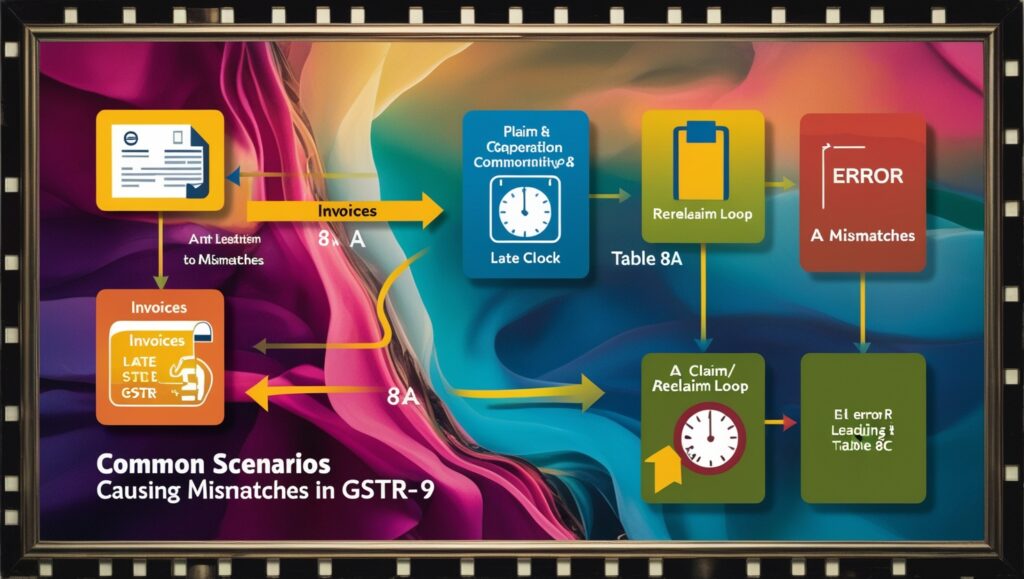Understanding and Resolving GSTR-9 Table 8A and 8C Mismatch for FY 2023-24
Filing annual GST returns is a critical process for taxpayers in India, and the accuracy of data reported in GSTR-9 Table 8A and 8C is paramount. With the introduction of new data sources and reporting rules for the financial year 2023-24, taxpayers have expressed concerns about mismatches between these two tables. This article will delve into the reasons for these discrepancies, scenarios where they arise, and the correct reporting methods to resolve them.

What Are Table 8A and Table 8C in GSTR-9?
The GSTR-9 Annual Return consolidates the financial details of a taxpayer, including purchases, sales, tax paid, and input tax credit (ITC) availed. Among its many sections, Table 8A and Table 8C specifically deal with ITC details.
Table 8A: Auto-Populated ITC
- For FY 2023-24, Table 8A is auto-populated from GSTR-2B, a static document that captures ITC details on a monthly basis.
- It includes ITC available from inward supplies during the financial year.
Table 8C: Manually Reported ITC
- Table 8C must be filled manually by the taxpayer.
- It captures ITC from inward supplies of FY 2023-24 that are availed in the subsequent financial year (up to the specified period).

Why Does a Mismatch Occur Between Table 8A and Table 8C?
The mismatch in GSTR-9 Table 8A and 8C can arise due to differences in the timing of reporting invoices and the transition from GSTR-2A to GSTR-2B as the data source. Here are some key reasons:
- Data Source Change:
- For FY 2022-23, Table 8A data was auto-populated from GSTR-2A.
- For FY 2023-24, it is derived from GSTR-2B, leading to differences in the reported ITC.
- Late Reporting by Suppliers:
- If a supplier files GSTR-1 after the due date of March 2024, the corresponding invoice may not appear in GSTR-2B for FY 2023-24.
- ITC Claimed in Subsequent Years:
- Invoices for FY 2023-24 may be reported late or goods may not be received in time, leading to ITC claims in FY 2024-25.
- Reversal and Reclaim of ITC:
- ITC reversed due to non-payment within 180 days, as per GST laws, and subsequently reclaimed adds complexity to reporting.

How to Address GSTR-9 Table 8A and 8C Mismatch?
To ensure accurate reporting and compliance, the Goods and Services Tax Network (GSTN) has issued specific guidelines for common scenarios of mismatch. Here’s a detailed explanation of each case:
1. Late Reporting by Suppliers
- Issue: An invoice from FY 2023-24 is reported late (post-March 2024) in GSTR-1 by the supplier. This invoice will not appear in Table 8A for FY 2023-24.
- Solution: Report this ITC in Table 8C and Table 13, as it pertains to FY 2023-24.
2. ITC Reversed and Reclaimed in the Next Financial Year
- Issue: ITC claimed in FY 2023-24 is reversed due to non-payment within 180 days and later reclaimed in FY 2024-25 after payment is made.
- Solution: Report the reclaimed ITC in Table 6H of GSTR-9 for FY 2024-25. It should not be included in Table 8C or Table 13 of FY 2023-24.
3. Goods Not Received in FY 2023-24
- Issue: Invoices for FY 2023-24 where goods are not received in the same year are initially reversed and later reclaimed in FY 2024-25.
- Solution: Report reclaimed ITC in Table 8C and Table 13, as it pertains to FY 2023-24.
4. Previous Year Invoices Auto-Populated in Table 8A
- Issue: Invoices from FY 2022-23, reported late, appear in Table 8A for FY 2023-24.
- Solution: Exclude these values from Table 8C and Table 13, as they belong to the previous financial year.
5. ITC Claimed, Reversed, and Reclaimed Within the Same Year
- Issue: If ITC is claimed, reversed, and reclaimed within FY 2023-24, it may lead to duplication or errors.
- Solution: Report this ITC either in Table 6B or Table 6H, but not both.
Best Practices to Avoid GSTR-9 Table 8A and 8C Mismatch
- Regular Reconciliation:
- Reconcile GSTR-2B data with purchase records monthly to ensure ITC claims are accurate.
- Follow Reporting Guidelines:
- Adhere to GSTN instructions for reporting ITC in Tables 8A, 8C, and 13.
- Monitor Supplier Compliance:
- Ensure suppliers file GSTR-1 on time to minimize discrepancies.
- Use Automated Tools:
- Leverage GST-compliant accounting software to track ITC and manage returns efficiently.
- Stay Updated:
- Keep abreast of GST notifications and advisories to understand reporting changes.
Impact of GSTR-9 Table 8A and 8C Mismatch
Discrepancies in GSTR-9 Table 8A and 8C can have serious implications, including:
- Compliance Issues:
- Incorrect reporting may result in notices or penalties from tax authorities.
- Financial Loss:
- Failure to claim eligible ITC due to reporting errors can lead to unnecessary tax outflows.
- Operational Delays:
Resolving mismatches through reconciliations and corrections can consume significant resources.
Conclusion
The GSTR-9 Table 8A and 8C mismatch is a common challenge for taxpayers in FY 2023-24, driven by changes in data sources and ITC reporting rules. By understanding the scenarios outlined above and following GSTN’s advisory, taxpayers can ensure accurate and compliant filing. Regular reconciliation, adherence to guidelines, and leveraging automation are critical steps to minimize discrepancies and maximize ITC benefits.
As GST regulations continue to evolve, staying informed and proactive will be essential for businesses to navigate these complexities successfully.
For more update GST Visit here.









